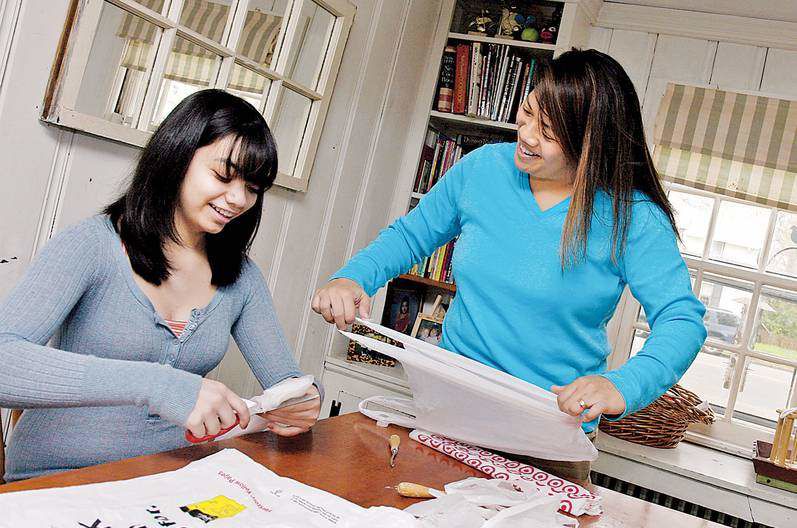Plastic bags get new life as hooked rugs
Published 5:00 am Wednesday, June 25, 2008

- Cecily Brady, left, and her mother, Michelle, of Newport News, Va., work on a plastic bag rug. Michelle found the craft idea online.
NEWPORT NEWS, Va. — When friends and neighbors heard the Brady family needed crafting materials for a special project, two-handled white plastic bags with Food Lion, Wal-Mart and Harris Teeter logos magically appeared on their doorstep in the Hilton area of Newport News, Va.
When they had more than 60 bags on hand, Michelle and daughter Cecily went to work, recycling the bags into a hooked rug that is now the talk of their friends.
“People who’ve seen the rug seem to think it’s cool,” says Michelle, 41. “One family friend decided to make her own.”
Michelle came across the idea last fall while researching creative ways to use old Christmas cards. One online site showed a raincoat and tote bags made of fused plastic bags. Another Web site featured hats crocheted from plastic bags and rugs woven with them. But, it was a photo of a rug hooked with plastic bags that snagged her interest.
“The designer talked about the durability of the rug; all she had to do was hose it of or shake it clean,” she says. “I thought the hooked rug was attractive and was suddenly struck by how many plastic bags I was storing in the house. I felt an immediate impulse to make one, even though I’ve never hooked a rug before.”
Cecily, 14, says the rug adds personality to her room.
“It’s something that none of my friends have, although a few are trying to save up plastic bags to make one,” says the Warwick High School student. “I really love it. I have it on the floor right in front of my door and next to my bed so it is one of the first things you seen when you come in my room. The rug itself is very soft, and the best part is you hose it off if it gets dirty.”
The rug is just one way the Brady family recycles. They compost their fruit and vegetable waste, use their city recycling bin religiously and try to reuse or re-purpose whatever they can, including the backs of used writing paper or the many tennis balls that Michelle goes through.
“Those were turned into wreaths at Christmas.”
Hook your own plastic bag rug Materials Directions
Hook your own plastic bag rug
Materials:
• Hooked rug backing from fabric or craft store
• Plastic grocery bags (flimsier ones labeled No. 2 work best; heavier bags marked No. 4 stretch and break easily); 60 bags were used for this project.
• Latch hook tool
• Latch-hook binding or duct tape
Directions:
• Smooth each bag flat.
• Cut off the handles and bottom.
• Make a cut up the side so you have a large flat piece.
• Cut each flat piece into strips 1 to 1 inches wide and 6 to 8 inches long. The easiest way to do this is to fold the cut-up bag into a smaller rectangle by pleating or folding it one direction only. Cut this rectangle into strips about 1 to 1 inches wide; then wrap those strips around a solid object (Michelle uses her hand) and cut across.
• Hook each strip into the rug backing, using the latch hook tool (easy instructions are on the Internet or with the latch-hook kits or ask a craft-fabric store employee).
• Leave a border of about three unhooked rows on the edges of the rug to make the binding more durable.
• Bind the finished hook rug by using rug binding or duct tape (the tape comes in many pretty colors) along the edges to keep the backing from unraveling.
Tips: For this rug, a 37-by-27-inch piece of rug backing makes a completed rug that measures about 40 inches by 30 inches, using about 60 plastic bags.
Time it takes: Michelle and Cecily worked on the rug several hours a week, totaling about 24 hours over a month’s time.
• Hooked rug backing from fabric or craft store
• Plastic grocery bags (flimsier ones labeled No. 2 work best; heavier bags marked No. 4 stretch and break easily); 60 bags were used for this project.
• Latch hook tool
• Latch-hook binding or duct tape
• Smooth each bag flat.
• Cut off the handles and bottom.
• Make a cut up the side so you have a large flat piece.
• Cut each flat piece into strips 1 to 1½ inches wide and 6 to 8 inches long. The easiest way to do this is to fold the cut-up bag into a smaller rectangle by pleating or folding it one direction only. Cut this rectangle into strips about 1 to 1½ inches wide; then wrap those strips around a solid object (Michelle uses her hand) and cut across.
• Hook each strip into the rug backing, using the latch hook tool (easy instructions are on the Internet or with the latch-hook kits or ask a craft-fabric store employee).
• Leave a border of about three unhooked rows on the edges of the rug to make the binding more durable.
• Bind the finished hook rug by using rug binding or duct tape (the tape comes in many colors) along the edges to keep the backing from unraveling.
Tips: For this rug, a 37-by-27-inch piece of rug backing makes a completed rug that measures about 40 inches by 30 inches, using about 60 plastic bags.
Time it takes: Michelle and Cecily worked on the rug several hours a week, totaling about 24 hours over a month’s time.






